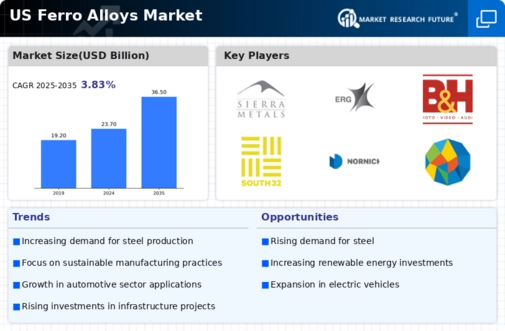The US Ferro Alloys Market showcases a robust and competitive landscape characterized by diverse players engaged in the production and distribution of essential ferro alloys, which are vital for various industries, particularly steel manufacturing. This sector is significantly influenced by fluctuating raw material prices, technological advancements, and evolving regulatory frameworks. The competition is marked by the presence of both established entities and emerging players, all striving to enhance their market share through innovation, strategic partnerships, and geographical expansion.
Market players are increasingly focusing on sustainable practices to align with global trends toward reducing carbon emissions, which adds another layer of complexity to the competitive dynamics. Understanding these competitive insights is crucial for stakeholders looking to navigate the challenges and opportunities inherent in this market. Sierra Metals has established a commendable presence in the US Ferro Alloys Market, leveraging its comprehensive portfolio of high-quality minerals. The company's strengths lie in its operational efficiency and advanced technological capabilities, which allow for the production of superior ferro alloys that meet rigorous industry standards.
Sierra Metals is characterized by its committed approach to sustainability and environmental stewardship, ensuring that its production processes minimize ecological impact. This focus on reducing carbon footprint aligns the company well with industry-facing regulatory requirements, positioning it favorably among environmentally conscious consumers. Furthermore, by employing a skilled workforce and investing in research and development, Sierra Metals continuously seeks to innovate its offerings, thereby enhancing its competitive edge in the US market. Eurasian Resources Group is a significant player in the US Ferro Alloys Market, recognized for its diverse range of products and robust operational capabilities.
The company specializes in the production of ferrochrome and other ferro alloys, essential for the steelmaking industry. With a strong emphasis on quality and compliance, Eurasian Resources Group has managed to build a reputation for reliability among its customer base. The company's strengths include its extensive supply chain, which is bolstered by strategic mergers and acquisitions aimed at expanding its production capacity and market reach. These moves have not only enhanced its operational prowess but have also allowed for more efficient resource management.
By fostering strong relationships with stakeholders, including suppliers and customers, Eurasian Resources Group enhances its market presence and continues to thrive amidst the competitive pressures of the US Ferro Alloys Market.























Leave a Comment